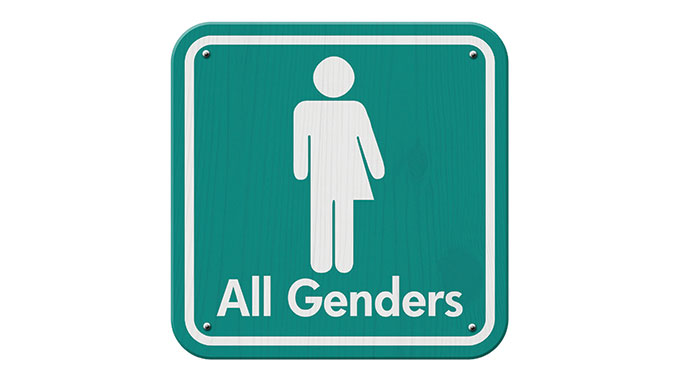
What to say when your child asks “what else is there?”
Published: October 30, 2019
By: Pam Moore
I recently took my daughter to the restroom at a local health food restaurant in a progressive city. As you might expect, the restroom was not labeled “men,” “women,” “family,” or even just “restroom.” It was “all genders.”
It didn’t occur to me to think about my daughter’s reaction to that term, given the potty emergency at hand. My daughter did not miss the sign, however. She asked, “What does ‘all genders’ mean?”
“Well, it means, men, women, and … anyone who doesn’t identify as a man or a woman.”
“But what else is there?” she asked.
“Like, someone who just wants to identify as a person.”
“But why can’t they just be a man or a woman.”
“Like I said. They just want to be a person.”
Back at our table, I whispered to my husband, “How do you explain non-binary gender to a kid?”
Not surprisingly, given that my husband, myself and our two daughters are cisgender, the topic of gender had never come up until we saw the “all genders” sign. According to Trans Student Education Resource’s website, the word “cisgender,” from the Latin “cis,” meaning “on the same side,” is an adjective that describes someone who identifies with the gender they were assigned at birth.
“For some people, the grown-ups guessed right about their body and their gender. This is called cisgender — when someone’s identity matches their sex assigned at birth,” according to Who Are You: The Kids Guide to Gender Identity, by Brook Pessin-Whedbee.
My husband and I have certainly talked with our kids about bodies, private parts, and where babies come from. But those were conversations about sexuality, not gender. So I was caught off-guard by the “all genders” sign, and unsure of how to begin to explain it.
When you talk about non-binary gender, talking about the gender binary is a good starting point, says Talcott Broadhead, author of Meet Polkadot, the illustrated story of a non-binary, transgender child. Broadhead explains that the gender binary refers to “who you should be, think, look, feel and act like” as a girl or as a boy.
The problem with the traditional gender binary is that people don’t always fit neatly into a prescribed notion of what it feels like to be a boy or a girl. Pessin-Whedbee explains that the sex you’re assigned at birth, whether it’s male or female, may not match your gender. While your sex is based on your body parts, gender is an expression of who you are — including what you feel, what you like, how you dress and “who you know yourself to be.”
In Pink is a Girl Color… and Other Silly Things People Say, author Stacy Drageset dispels some common myths for young readers. For example, ballet is not just for girls and anyone can play basketball. Drageset explains that rather than choosing clothes based on whether they are “boy clothes” or “girl clothes,” it is more important to dress according to what you like and feel comfortable in.
“There are lots of ways to be a boy. There are lots of ways to be a girl,” Pessin-Whedbee writes. “There are lots of ways to be a kid.”
She lists a number of other ways in which people may choose to identify themselves, including trans, genderqueer, non-binary, gender fluid, transgender, gender neutral, agender, neutrois, bigender, third gender, and two-spirit.
While Pessin-Whedbee refers to the gender spectrum as an alternative to the gender binary, Broadhead’s book does not. Broadhead, who uses the pronoun “they,” explained that the notion of a gender spectrum implies that male and female occupy distinct ends of a scale, whereas “they” feel gender is in fact too fluid and unique a concept to fit a linear model. They prefer the concept of gender diversity, which includes a gender universe, in which “we are each our own star.” Whether taking the approach of a gender spectrum or a gender universe, experts agree that you are the only one who gets to say who or what you are (with the caveat that the term “two-spirit” is specific to certain indigenous cultures.)
Heather Thompson, a self-identified genderqueer person and advocate for “queer, trans, and non-binary folks,” recommends using everyday encounters to open conversations with children about gender. For example, when my 5-year-old asks me why our cashier has an earring “even though he’s a boy,” I can take the opportunity to explain that you don’t actually know what a person is when you meet them.
A mother herself, Thompson acknowledges that kids often understand a lot more than we give them credit for. “In my experience, they get the middle [of the gender spectrum],”
she says, “they just didn’t know we could talk about it.”
Certainly books like the ones mentioned can be great conversation starters, as well. For parents who are reluctant to open a dialogue about gender for fear of not having all the answers, or feeling that they should have opened the conversation earlier, Broadhead says it’s OK to say something like: “I’m sorry I wasn’t actually sharing everything I know about gender. You and I know a lot about our own gender and it makes sense to us and it’s who we are, but what I haven’t explained to you is that there’s actually a lot more genders.”
And if they have questions you can’t answer, you can visit websites like the Trans Youth Equality Foundation (http://www.transyouthequality.org) or ask someone who would know. However, Broadhead cautions against cornering the trans parent at your child’s school in the pick-up line and interrogating her. “That’s obviously inappropriate.”
And of course, dining in a restaurant with an “all genders” restroom sign can work quite well, too.

